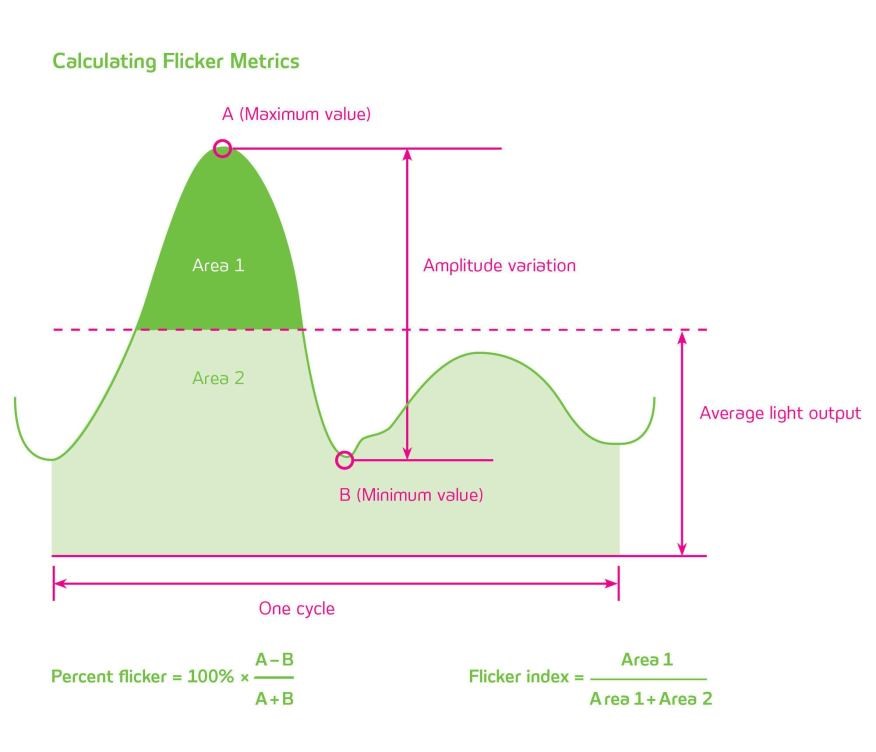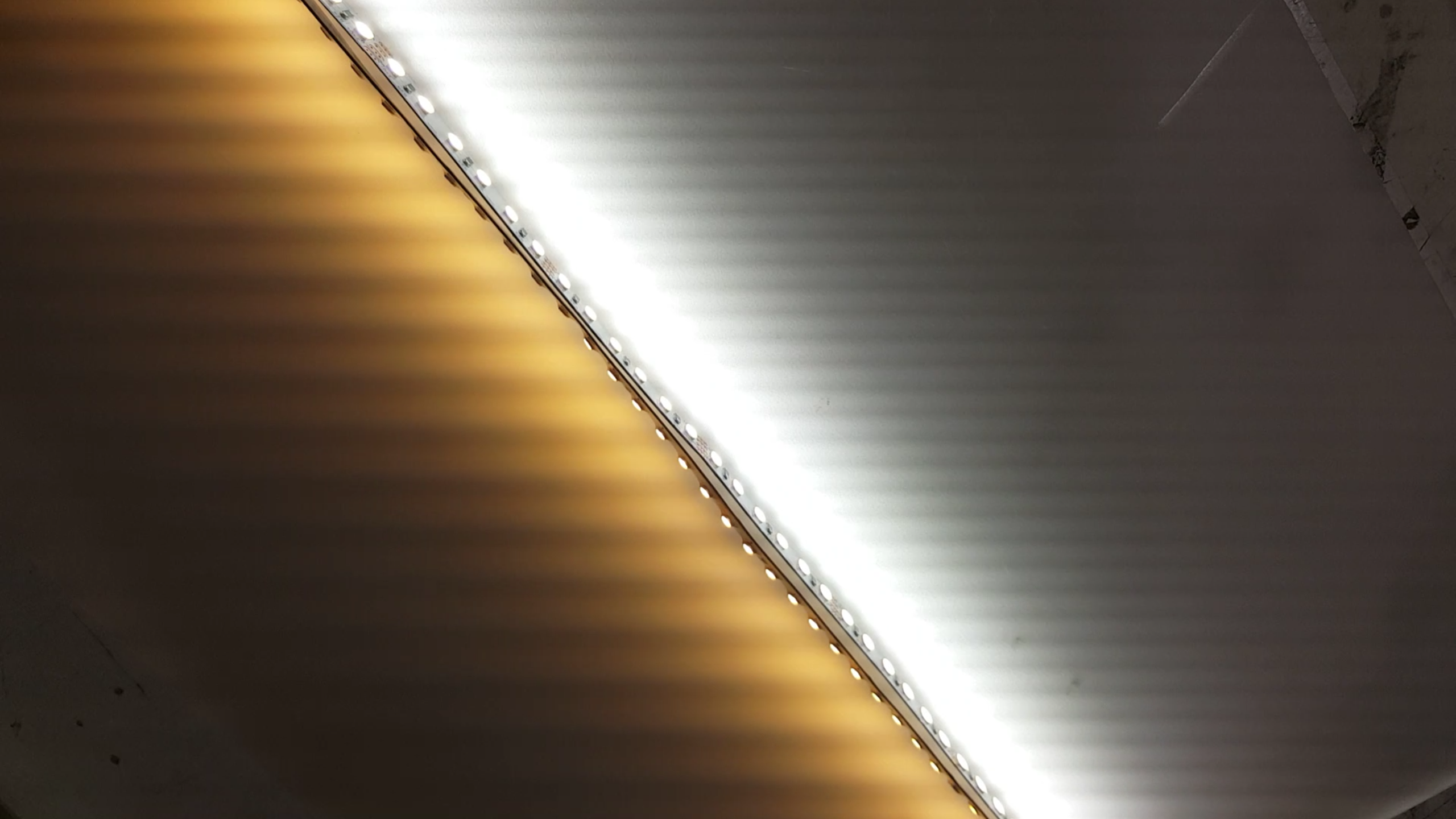What is the best way to achieve Flicker-Free LED Lighting?
If you’ve ever noticed the lights flickering, chances are it’s due to fluctuations in power. This produces a flicker effect, from a barely-perceptible “ripple” to more obvious strobing. Prolonged exposure to light flicker isn’t just annoying, it can have a significant impact on workers’ well being, students’ concentration levels, patients’ recovery times and generally reduce the performance of a lighting system. So what can you do to ensure flicker-free LED lighting in your home or workplace?

To test for lighting flicker, wave pencil or, as above, an extended measuring tape under the light source. If flicker exists, gaps will be apparent in the movement.
Why does my light flicker?
The simple explanation is that when the output of a light source fluctuates, the light will appear to flicker or ripple. The fluctuations are caused by the light output switching on and off, generally due to changes in the magnitude of the power voltage, or the “ripple” of alternating current. The frequency of the flicker – measured in Hertz (Hz) – determines how noticeable it is.
Most humans can observe flicker at frequencies below 50-70Hz, and studies have found that some people can even sense flicker at frequencies of 100Hz and above, while some may pick up even higher frequencies on a subconscious level, making it hard to determine their effect.
All types of lighting are prone to flicker, whether incandescent, halogen, fluorescent or LED, although it’s true that it can harder to detect with less energy-efficient lighting types, such as incandescent. This is a by-product of the bulb’s inefficiency: the filament retains heat – known as thermal persistence – and continues to glow despite power fluctuations.
LEDs do not suffer from thermal persistence, so when the power supply is switched off, the light output stops immediately. This means that if an LED is connected directly to a 50Hz AC mains electricity supply, the LED will turn on and off 50 times a second, which is noticeable to the human eye. However, this can easily be fixed by implementing a well-designed LED driver or control system that regulates the frequency of your mains power supply. With the right equipment, designed and specified to meet the requirements of your mains power and the environment of the system, flicker can be almost completely eliminated.
What are the Effects of Flicker?
The consequences of light flicker can range from simply annoying to more severe impacts on health. It has been shown to cause eyestrain, fatigue and make it harder to concentrate. A significant proportion of people are so sensitive to the changes in light frequency that it can cause neurological issues such as headaches, migraines, and for epileptics, it can be a direct trigger for seizures.
Light flicker can also create a stroboscopic effect which causes objects in motion to appear slowed-down. What may look great in a night club, can be extremely dangerous in an industrial setting, where it could cause moving gears or blades to appear slower or even stationary.
Although the lighting industry has readily adopted solid-state LED lighting as the gold standard in energy efficiency, lighting designers often fail to recognise that the effects of flicker can render spaces such as offices and factories unfit for purpose.
Research suggests that as the flicker frequency increases into the kilohertz range, it is no longer perceptible. The key is finding a method of achieving a high frequency that is suitable for your lighting system.

How does Flicker affect LED lighting?
Because LEDs have no persistence, the light output frequency will correlate with the output waveform of the power source or driver. With a basic LED driver, the output frequency is typically amplified to double the frequency of the input; for example, if the input voltage frequency is 50Hz, the ripple frequency potential would be 100Hz. This produces a flicker frequency that is barely perceptible to most humans, but prolonged exposure can still cause eye strain, fatigue and headaches.
Flicker can also be produced by pulse width modulation (PWM), a common dimming technique. Since this method simply moderates the power input to the LED, light flicker will be highly evident unless the PWM frequency is also regulated.
With a high-quality LED driver, it’s possible to increase the output to a very high frequency exceeding several thousand hertz, which is imperceptible to the human eye. However, this requires the LED driver to be placed close to the LED light, which isn’t always feasible in a standard lighting system. Thus this technique is generally restricted to professional use, for example lighting for film and television shoots.
What to consider when designing LED driver and Control systems
One way to achieve flicker-free LED Lighting is to add a capacitor to the driver output that buffers the output ripple. Unfortunately, this potentially reduces the lifespan and reliability of the system, especially if low-quality capacitors are used.
Another method is to use drivers with a two-stage power factor correction (PFC), which will modulate the output frequency, ripple and noise.
In either case, it is crucial to select a good quality LED driver that minimises fluctuations in the output ripple current, so that you can be sure to avoid undesirable effects. Lighting designers should work with LED Driver manufacturers and suppliers to identify a solution that is compatible with all aspects of the luminaire design, insulation and/or application considered.

Spec Tips for Flicker-Free LED Lighting
Lighting professionals can take some steps to reduce their chances of specifying solid-state lighting products that flicker. Be wary of products advertised as AC-LEDs. The simpler circuit design , lack of a driver, and consequently, low price may seem attractive, but some AC-LEDs can produce up to 40% flicker at full output. At dimmed levels, the flicker percentage can be even higher. Also, ensure that your driver supplier/specifier understands flicker and how this is affected by the driver. Trusted advice is key to find the right balance between cost and performance and most importantly, ensuring the best quality of light for any installation.
Visit our Products page for LED drivers that power flicker-free LED lighting >

